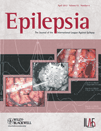Calcified neurocysticercosis lesions and hippocampal sclerosis: Potential dual pathology?
Summary
In areas where cysticercosis is endemic, calcified neurocysticercosis lesion(s) (CNL) and hippocampal sclerosis (HS) commonly coexist in patients with localization-related epilepsies. To understand the pathogenesis of HS associated with CNL, we compared the characteristics of three groups of patients with antiepileptic drug–resistant epilepsies: CNL with HS, CNL without HS (CNL alone), and HS without CNL (HS alone). In comparison to patients with CNL alone, those with CNL with HS had CNL more frequently located in the ipsilateral temporal lobe. Those with CNL with HS had a lower incidence of febrile seizures, older age at initial precipitating injury and at onset of habitual complex partial seizures, and more frequent clustering of seizures and extratemporal/bitemporal interictal epileptiform discharges as compared to patients with HS alone. Our study illustrates that HS associated with CNL might have a different pathophysiologic basis as compared to classical HS.




